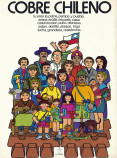How to Call for Collective Action

Visual language was one of the tools used to publicise and drive the social transformations underway. City walls were plastered with large, colourful posters to promote the political programme, education for all, and culture.
The pieces designed by Vicente and Antonio Larrea, Luis Albornoz, Ximena del Campo, Waldo González, Mario Quiroz and the Graphic Workshop at the Technical State University, among others, shaped a vision that spread through the streets. Graphically, it was characterised by the iconography of its colourful illustrations, the high contrast of the photographs and the evocation of Latin American styles. Regarding the work with text, transferable typefaces and signs were key elements. Screen and offset printing were used to produce the pieces, making it possible to produce a large number of copies in different tones.
These elements modulated a series of evocative symbols, which engaged in a fruitful, complementary dialogue with the language of the street mural brigades. Posters played a key role in creating a unique visual system. This system was reflected in different formats, spaces and uses. Its goal was to communicate and disseminate the principles of the revolutionary process, while also helping to construct a visual identity suitable for an egalitarian society

